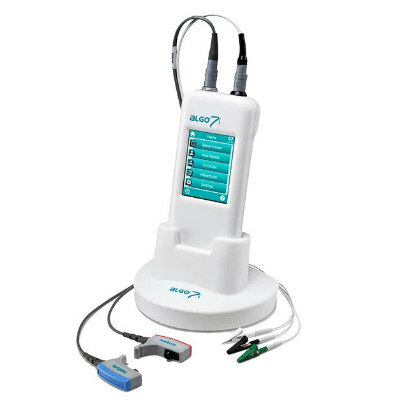Ultrasound Thalamotomy Relieves Parkinson's Disease Tremors 
|
By HospiMedica International staff writers Posted on 26 Feb 2020 |

Image: The InSightec ExAblate Neuro MRgFUS machine used in the study (Photo courtesy of University of L`Aquila)
Focused ultrasound thalamotomy provides a minimally invasive treatment option for patients with Parkinson's disease (PD) or essential tremor (ET), according to a new study.
Researchers at the University of L'Aquila (Italy) conducted a study involving 39 patients (average age 64.5 years), including 18 with ET and 21 with PD, who suffered from disabling tremors for an average of more than 10 years, and who had not responded to standard treatments. Patients were evaluated for tremor severity and quality of life before magnetic resonance-guided focused ultrasound (MRgFUS) thalamotomy, immediately after treatment, and over the course of the ensuing year. The procedures were performed with the InSightec (Dallas, TX, USA) ExAblate Neuro device, under guidance of a 3T MRI scanner.
The results revealed that 37 of 39 patients (95%) had substantial and immediate reduction of tremor, which were sustained during follow-up evaluations. Changes in fractional anisotropy and apparent diffusion coefficient (ADC) values in the ventral intermediate nucleus were statistically significant, but only changes in fractional anisotropy values correlated with clinical changes (based on the Fahn-Tolosa-Marin scale). In addition, quality of life was substantially improved in both the ET and PD groups. The study was presented at the Radiological Society of North America (RSNA) annual conference, held during November 2019 in Chicago (IL, USA).
“As a minimally invasive approach, focused ultrasound has advantages over deep brain stimulation, including a reduced risk of complications from bleeding and infections,” said lead author radiologist Federico Bruno, MD, of the department of biotechnological and applied clinical sciences. “Another advantage is the immediate effect this treatment provides, unlike deep brain stimulation which requires a break-in period for the electrostimulation. Additionally, treatment with MRgFUS requires shorter hospitalization, and is a fairly well-tolerated procedure even by more fragile patients.”
Focused ultrasound technology is based on nonlinear acoustic mathematical optimization methods to analyze and simulate the propagation of sound in material. The information is then used to enhance the shape of an acoustic lens in such a way that that ultrasound pressure is focused precisely on the location of the tissue to be ablated, while the surrounding tissue retains as little damage as possible.
Related Links:
University of L'Aquila
InSightec
Researchers at the University of L'Aquila (Italy) conducted a study involving 39 patients (average age 64.5 years), including 18 with ET and 21 with PD, who suffered from disabling tremors for an average of more than 10 years, and who had not responded to standard treatments. Patients were evaluated for tremor severity and quality of life before magnetic resonance-guided focused ultrasound (MRgFUS) thalamotomy, immediately after treatment, and over the course of the ensuing year. The procedures were performed with the InSightec (Dallas, TX, USA) ExAblate Neuro device, under guidance of a 3T MRI scanner.
The results revealed that 37 of 39 patients (95%) had substantial and immediate reduction of tremor, which were sustained during follow-up evaluations. Changes in fractional anisotropy and apparent diffusion coefficient (ADC) values in the ventral intermediate nucleus were statistically significant, but only changes in fractional anisotropy values correlated with clinical changes (based on the Fahn-Tolosa-Marin scale). In addition, quality of life was substantially improved in both the ET and PD groups. The study was presented at the Radiological Society of North America (RSNA) annual conference, held during November 2019 in Chicago (IL, USA).
“As a minimally invasive approach, focused ultrasound has advantages over deep brain stimulation, including a reduced risk of complications from bleeding and infections,” said lead author radiologist Federico Bruno, MD, of the department of biotechnological and applied clinical sciences. “Another advantage is the immediate effect this treatment provides, unlike deep brain stimulation which requires a break-in period for the electrostimulation. Additionally, treatment with MRgFUS requires shorter hospitalization, and is a fairly well-tolerated procedure even by more fragile patients.”
Focused ultrasound technology is based on nonlinear acoustic mathematical optimization methods to analyze and simulate the propagation of sound in material. The information is then used to enhance the shape of an acoustic lens in such a way that that ultrasound pressure is focused precisely on the location of the tissue to be ablated, while the surrounding tissue retains as little damage as possible.
Related Links:
University of L'Aquila
InSightec
Latest Surgical Techniques News
- Hydrogel-Based Miniaturized Electric Generators to Power Biomedical Devices
- Custom 3D-Printed Orthopedic Implants Transform Joint Replacement Surgery
- Wearable Technology Monitors and Analyzes Surgeons' Posture during Long Surgical Procedures
- Cutting-Edge Imaging Platform Detects Residual Breast Cancer Missed During Lumpectomy Surgery
- Computational Models Predict Heart Valve Leakage in Children
- Breakthrough Device Enables Clear and Real-Time Visual Guidance for Effective Cardiovascular Interventions
- World’s First Microscopic Probe to Revolutionize Early Cancer Diagnosis
- World’s Smallest Implantable Brain Stimulator Demonstrated in Human Patient

- Robotically Assisted Lung Transplants Could Soon Become a Reality
- AI to Provide Heart Transplant Surgeons with New Decision-Making Data
- New Surgical Tool Empowers Precision and Confidence in Operating Room
- Future Muscle-Powered Surgical Robots Could Perform Minimally Invasive Procedures inside Body
- Non-Invasive Technique Combines Cardiac CT with AI-Powered Blood Flow for Heart Bypass Surgery
- First-Of-Its-Kind Device Repairs Leaky Tricuspid Heart Valve
- New Signaling Method Enables Precise Localization of Miniature Robots and Surgical Instruments inside Body
- Novel Catheter System Enables Safer, More Cost-Effective Transseptal Procedures
Channels
Artificial Intelligence
view channel
AI-Powered Algorithm to Revolutionize Detection of Atrial Fibrillation
Atrial fibrillation (AFib), a condition characterized by an irregular and often rapid heart rate, is linked to increased risks of stroke and heart failure. This is because the irregular heartbeat in AFib... Read more
AI Diagnostic Tool Accurately Detects Valvular Disorders Often Missed by Doctors
Doctors generally use stethoscopes to listen for the characteristic lub-dub sounds made by heart valves opening and closing. They also listen for less prominent sounds that indicate problems with these valves.... Read moreCritical Care
view channel
Deep-Learning Model Predicts Arrhythmia 30 Minutes before Onset
Atrial fibrillation, the most common type of cardiac arrhythmia worldwide, affected approximately 59 million people in 2019. Characterized by an irregular and often rapid heart rate, atrial fibrillation... Read more
Breakthrough Technology Combines Detection and Treatment of Nerve-Related Disorders in Single Procedure
The peripheral nervous system (PNS) serves as the communication network that links the brain and spinal cord to every other part of the body. It consists of two parts: the somatic nervous system, which... Read morePatient Care
view channel
Surgical Capacity Optimization Solution Helps Hospitals Boost OR Utilization
An innovative solution has the capability to transform surgical capacity utilization by targeting the root cause of surgical block time inefficiencies. Fujitsu Limited’s (Tokyo, Japan) Surgical Capacity... Read more
Game-Changing Innovation in Surgical Instrument Sterilization Significantly Improves OR Throughput
A groundbreaking innovation enables hospitals to significantly improve instrument processing time and throughput in operating rooms (ORs) and sterile processing departments. Turbett Surgical, Inc.... Read more
Next Gen ICU Bed to Help Address Complex Critical Care Needs
As the critical care environment becomes increasingly demanding and complex due to evolving hospital needs, there is a pressing requirement for innovations that can facilitate patient recovery.... Read moreGroundbreaking AI-Powered UV-C Disinfection Technology Redefines Infection Control Landscape
Healthcare-associated infection (HCAI) is a widespread complication in healthcare management, posing a significant health risk due to its potential to increase patient morbidity and mortality, prolong... Read moreHealth IT
view channel
Machine Learning Model Improves Mortality Risk Prediction for Cardiac Surgery Patients
Machine learning algorithms have been deployed to create predictive models in various medical fields, with some demonstrating improved outcomes compared to their standard-of-care counterparts.... Read more
Strategic Collaboration to Develop and Integrate Generative AI into Healthcare
Top industry experts have underscored the immediate requirement for healthcare systems and hospitals to respond to severe cost and margin pressures. Close to half of U.S. hospitals ended 2022 in the red... Read more
AI-Enabled Operating Rooms Solution Helps Hospitals Maximize Utilization and Unlock Capacity
For healthcare organizations, optimizing operating room (OR) utilization during prime time hours is a complex challenge. Surgeons and clinics face difficulties in finding available slots for booking cases,... Read more
AI Predicts Pancreatic Cancer Three Years before Diagnosis from Patients’ Medical Records
Screening for common cancers like breast, cervix, and prostate cancer relies on relatively simple and highly effective techniques, such as mammograms, Pap smears, and blood tests. These methods have revolutionized... Read morePoint of Care
view channel
Critical Bleeding Management System to Help Hospitals Further Standardize Viscoelastic Testing
Surgical procedures are often accompanied by significant blood loss and the subsequent high likelihood of the need for allogeneic blood transfusions. These transfusions, while critical, are linked to various... Read more
Point of Care HIV Test Enables Early Infection Diagnosis for Infants
Early diagnosis and initiation of treatment are crucial for the survival of infants infected with HIV (human immunodeficiency virus). Without treatment, approximately 50% of infants who acquire HIV during... Read more
Whole Blood Rapid Test Aids Assessment of Concussion at Patient's Bedside
In the United States annually, approximately five million individuals seek emergency department care for traumatic brain injuries (TBIs), yet over half of those suspecting a concussion may never get it checked.... Read more
New Generation Glucose Hospital Meter System Ensures Accurate, Interference-Free and Safe Use
A new generation glucose hospital meter system now comes with several features that make hospital glucose testing easier and more secure while continuing to offer accuracy, freedom from interference, and... Read moreBusiness
view channel
Johnson & Johnson Acquires Cardiovascular Medical Device Company Shockwave Medical
Johnson & Johnson (New Brunswick, N.J., USA) and Shockwave Medical (Santa Clara, CA, USA) have entered into a definitive agreement under which Johnson & Johnson will acquire all of Shockwave’s... Read more
















